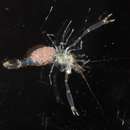en
names in breadcrumbs


Periclimenes, commonly known as glass shrimp or cleaner shrimp, is a commensal and often symbiotic genus of semi-transparent shrimp within the family Palaemonidae.[3][4] Species of this large genus feature a wide variety of coloration and patterns, widespread distribution throughout much of the world's tropical oceans, and are often sought out for aquarium trade.[5]
This genus has undergone several changes in classification based on recent molecular studies comparing species within the genus. However, most recent molecular studies have only involved approximately 20% of the known species likely to belong to the genus. Additionally, most of the molecular studies performed involved Indo-Pacific species of Periclimenes and did not include presumed Periclimenes found in the Atlantic Ocean. Periclimenes has previously been suggested as being a polyphyletic taxa, and has already undergone splits into several new genera. It is likely the genus will undergo changes in classification in coming years with further research.[6]
The genus contains the following species:[7]
Periclimenes is widely distributed throughout tropical and temperate reef ecosystems of the Atlantic, Caribbean, Mediterranean, as well as Indo-Pacific Oceans.[8][9]
Many species of Periclimenes are commensal and often symbiotic organisms within their reef ecosystems. The most common organisms forming symbiotic relationships with this genus are species of fish, cnidarians, echinoderms, and sponges. Some species such as Periclimenes caraibicus have been observed to interact parasitically with species of sponges, living within the sponge and directly eating the sponge tissue. Another species, Periclimenes soror, is commonly found on a species of sea star known as cushion stars with no effect on the star making it a commensalistic relationship. Anecdotal evidence suggests that P. soror may choose a host star that matches its own coloration for camouflage.[10] Other research demonstrated that the Periclimenes species, P. yucatanicus, has a symbiotic cleaning relationship with different species of reef fish studied in the pacific. P. yucatanicus performed a waving motion with its antennae to signal to reef fish that it is available to clean. The cleaner shrimps then ate parasitic organisms present on the reef fish species.[11]
Species present in this genus typically have a transparent to semi transparent body with antennae protruding from the head region. Additionally, large variation of color and patterns exist on the organisms throughout, making them highly sought out ornamental species in the marine aquarium industry.[12]
Periclimenes soror on a pillow starfish Culcita schmideliana.
{{cite journal}}: CS1 maint: multiple names: authors list (link) {{cite journal}}: CS1 maint: multiple names: authors list (link) {{cite journal}}: CS1 maint: multiple names: authors list (link) {{cite journal}}: CS1 maint: multiple names: authors list (link) Periclimenes, commonly known as glass shrimp or cleaner shrimp, is a commensal and often symbiotic genus of semi-transparent shrimp within the family Palaemonidae. Species of this large genus feature a wide variety of coloration and patterns, widespread distribution throughout much of the world's tropical oceans, and are often sought out for aquarium trade.